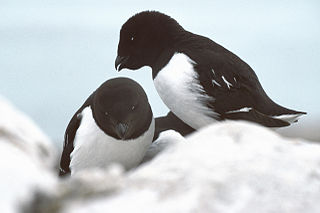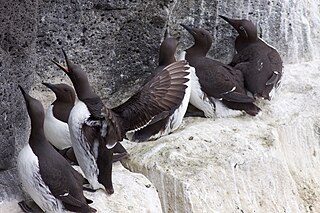 W
WThe great auk is a species of flightless alcid that became extinct in the mid-19th century. It was the only modern species in the genus Pinguinus. It is not closely related to the birds now known as penguins, which were discovered later and so named by sailors because of their physical resemblance to the great auk.
 W
WThe little auk or dovekie is a small auk, the only member of the genus Alle. Alle is the Sami name of the long-tailed duck; it is onomatopoeic and imitates the call of the drake duck. Linnaeus was not particularly familiar with the winter plumages of either the auk or the duck, and appears to have confused the two species. Other common names include rotch, rotche, and sea dove, although this last sometimes refers to a different auk, the Black Guillemot, instead.
 W
WThe pink-footed goose is a goose which breeds in eastern Greenland, Iceland and Svalbard. It is migratory, wintering in northwest Europe, especially Ireland, Great Britain, the Netherlands, and western Denmark. The name is often abbreviated in colloquial usage to "pinkfoot". Anser is the Latin for "goose", and brachyrhynchus comes from the ancient Greek brachus "short" and rhunchos "bill".
 W
WGuillemot is the common name for several species of seabird in the Alcidae or auk family. In British use, the term comprises two genera: Uria and Cepphus. In North America the Uria species are called "murres" and only the Cepphus species are called "guillemots". This word of French origin derives from a form of the name William, cf. French: Guillaume.
 W
WRoss's gull is a small gull, the only species in its genus, although it has been suggested it should be moved to the genus Hydrocoloeus, which otherwise only includes the little gull. This bird is named after the British explorer James Clark Ross. Its breeding grounds were first discovered in 1905 by Sergei Aleksandrovich Buturlin near village of Pokhodsk in North-Eastern Yakutia, while visiting the area as a judge. The genus name Rhodostethia is from Ancient Greek rhodon, "rose", and stethos, "breast". The specific rosea is Latin for "rose-coloured".
 W
WSabine's gull, also known as the fork-tailed gull or xeme, is a small gull. Its generic placement is disputed; some authors treat it as the sole species in the genus Xema as Xema sabini, while others retain it in the genus Larus as Larus sabini.
 W
WThe common loon or great northern diver is a large member of the loon, or diver, family of birds. Breeding adults have a plumage that includes a broad black head and neck with a greenish, purplish, or bluish sheen, blackish or blackish-grey upperparts, and pure white underparts except some black on the undertail coverts and vent. Non-breeding adults are brownish with a dark neck and head marked with dark grey-brown. Their upperparts are dark brownish-grey with an unclear pattern of squares on the shoulders, and the underparts, lower face, chin, and throat are whitish. The sexes look alike, though males are significantly heavier than females. During the breeding season, loons live on lakes and other waterways in Canada; the northern United States ; and southern parts of Greenland and Iceland. Small numbers breed on Svalbard and sporadically elsewhere in Arctic Eurasia. Common loons winter on both coasts of the US as far south as Mexico, and on the Atlantic coast of Europe.
 W
WThe common ringed plover or ringed plover is a small plover that breeds in Arctic Eurasia. The genus name Charadrius is a Late Latin word for a yellowish bird mentioned in the fourth-century Vulgate. It derives from Ancient Greek kharadrios a bird found in ravines and river valleys. The specific hiaticula is Latin and has a similar meaning to the Greek term, coming from hiatus, "cleft" and -cola, "dweller".
 W
WThe razorbill or lesser auk is a colonial seabird in the monotypic genus Alca of the family Alcidae, the auks. It is the closest living relative of the extinct great auk. Wild populations live in the subarctic waters of the Atlantic Ocean.